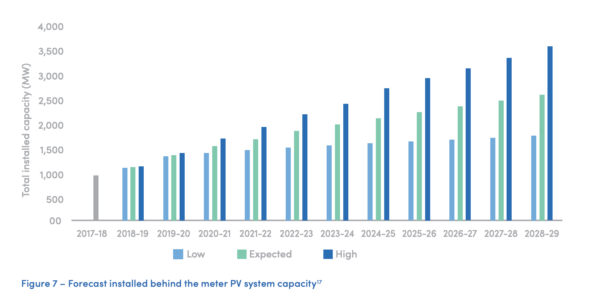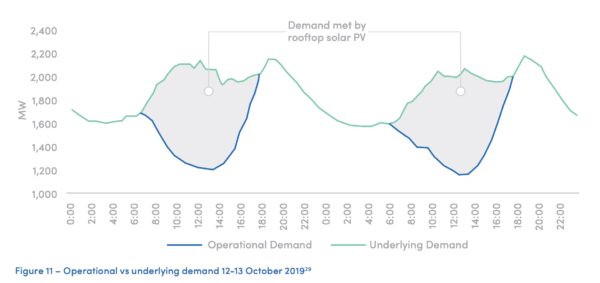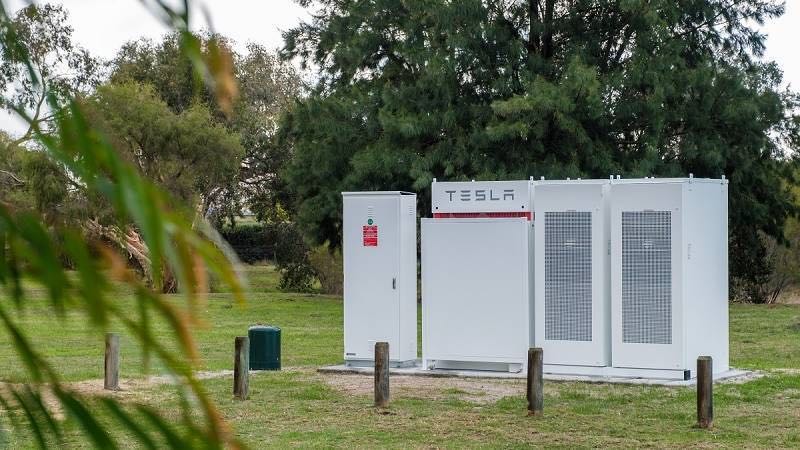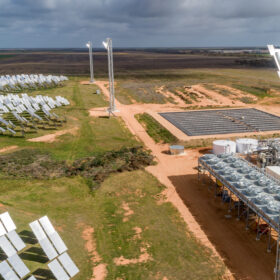The coastal city of Busselton last week became the fifth Western Australian community to receive a centralised battery storage system, which will help households make better use of energy generated by their rooftop solar systems, while supporting the South West Integrated System (SWIS) in providing reliable energy services.
Busselton, famous for its 1.8-kilometre 19th century jetty, has also become a leader in the solar space, “with more than 4,700 rooftops featuring solar panels,” said South West Member of the state’s Legislative Council, Sally Talbot, on the launch of the battery.
The Western Australian grid has been groaning under the ever-growing supply of distributed rooftop solar: one in three households in the SWIS today lives under solar, and the rate of uptake is still growing at around 2,000 households a month.

Image: Distributed Energy Resources Roadmap
Smoothing the effects of massive rooftop generation
High penetrations of such distributed energy resources (DER) have dramatically changed energy flows within the SWIS: in the fourth quarter of 2018, for example, energy produced by residential and small businesses connected to WA’s Wholesale Electricity Market (WEM) were sometimes greater than their total demand — an upturning of the norm that threatens stability of the system.
In addition, the viability of Synergy, the electricity and gas provider throughout the SWIS has been severely challenged by this residential energy transition.
At the beginning of 2018, pv magazine reported that the gentailer was “dealing with grid demand that is declining during the middle of the day due a buoyant solar sector, and the challenge of operating ageing coal and gas generation assets. At the same time it is being squeezed between an economy in which some households are struggling to meet bill repayments and a state government that is looking to wind back subsidies on electricity bills to plug its budget.”
In May 2019, WA’s Energy Minister Bill Johnston appointed an Energy Transition Taskforce to look ahead at the requirements emerging through the state’s energy transition; it was charged, with among other things, formulating a Distributed Energy Resources Roadmap — released in April this year.

Image: Distributed Energy Resources Roadmap
Shareable, controllable storage lays the groundwork for a stable system
Among its recommendations was to immediately begin installing community-scale batteries in 10 locations across the SWIS network.
The reasoning is that customers would like to balance the use of their solar throughout the energy-consuming day, but most can’t yet afford the cost of a battery behind the meter that would allow them to store energy when the sun is shining for use in the evening when the price of energy from the grid is at its peak; at the same time, being able to store excess solar generation in the middle of the day would help support the region’s power supply in times of peak demand — generally between 4pm and 8pm.
Customers who participated in the original trial of a 105 kW/420 kWh battery in Meadow Springs collectively saved around $11,000 on their power bills, or an average of $228 per customer over the battery’s first year of operation.
The rollout continues with 116 kW/464 kWh Tesla batteries installed in Falcon (Mandurah), Ellenbrook (Perth) and Kalgoorlie.
From September, “The Busselton community battery will allow residents with solar panels to store excess solar power for use during peak times,” said Minister Johnston of the latest installation.
Although Synergy has not yet made clear the model for use of the battery, in the Meadow Springs trial, for example, customers were charged between $1 and $2 a day to store 6-8 kW of energy and draw it back as needed.
Such “virtual” storage options offer a more cost-effective way for households to access storage, and, notes the WA DER Roadmap, “Larger battery banks also achieve economies of scale and lower installation costs,” than smaller individual behind-the-meter batteries can.
Ironing out the details and regulatory kinks as you go
The Energy Transition Taskforce recommended that Western Power use findings from the deployment of the 10 batteries to highlight network issues that storage can alleviate, and seek “market input on an approach to the widespread deployment of distribution storage in 2021-2024 and beyond.”
The Taskforce expects that models will emerge for third parties to provide batteries as a service to WA communities and Western Power.
By December this year, the Roadmap requires that Western Power will have implemented appropriate metering and settlement arrangements for distribution storage; and by December 2021, it is expected that Western Power will have updated the Technical Rules to “clarify the requirements for distribution battery storage beyond the current treatment as both a generator and a load”.
“There is so much to learn about how to integrate battery storage technology into the sector,” said Synergy CEO Jason Waters at the unveiling of the Ellenbrook battery.
In addition to providing cost-effective solar storage options, community batteries also maintain capacity for the grid to cope with “more solar to be installed in the future”, said Western Power Acting CEO David Fyfe.
This content is protected by copyright and may not be reused. If you want to cooperate with us and would like to reuse some of our content, please contact: editors@pv-magazine.com.








1 comment
By submitting this form you agree to pv magazine using your data for the purposes of publishing your comment.
Your personal data will only be disclosed or otherwise transmitted to third parties for the purposes of spam filtering or if this is necessary for technical maintenance of the website. Any other transfer to third parties will not take place unless this is justified on the basis of applicable data protection regulations or if pv magazine is legally obliged to do so.
You may revoke this consent at any time with effect for the future, in which case your personal data will be deleted immediately. Otherwise, your data will be deleted if pv magazine has processed your request or the purpose of data storage is fulfilled.
Further information on data privacy can be found in our Data Protection Policy.